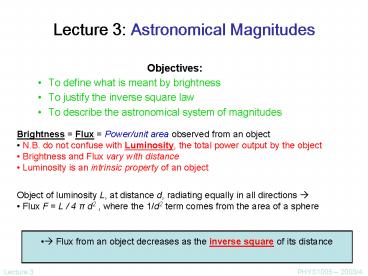Lecture 3: Astronomical Magnitudes PowerPoint PPT Presentation
1 / 5
Title: Lecture 3: Astronomical Magnitudes
1
Lecture 3 Astronomical Magnitudes
- Objectives
- To define what is meant by brightness
- To justify the inverse square law
- To describe the astronomical system of magnitudes
- Brightness Flux Power/unit area observed from
an object - N.B. do not confuse with Luminosity, the total
power output by the object - Brightness and Flux vary with distance
- Luminosity is an intrinsic property of an object
- Object of luminosity L, at distance d, radiating
equally in all directions ? - Flux F L / 4 p d2 , where the 1/d2 term comes
from the area of a sphere
- ? Flux from an object decreases as the inverse
square of its distance
2
- e.g. Suns luminosity LO 3.8 x 1026 W and it is
1AU (1.5 x 1011 m) distant - what is the flux from the Sun at Earth?
- Answer 1,350 W m-2 (verify)
- what would the flux be at 10 pc?
- Answer 3.18 x 10-10 W m-2 (verify)
Astronomical Magnitude System
- Hipparchus (120 BC) classified stars into 6
levels (1 brightest, 6 faintest) - but measurements in 19th century ?
- eye response is logarithmic! ? 5 magnitudes x
100 - Pogson (1856) defined 5 magnitudes exactly
factor 100 in brightness - (unfortunately) he kept 1 as bright and 6 as
faint! - mathematical definition m1 m2 -2.5 log10
(F1/F2) - (check by putting F1 100 F2)
- N.B. Faint stars have large magnitudes
3
Apparent and Absolute Magnitudes
- Magnitudes measured relative to Vega defined to
have m 0 - ?6th mag faintest you can see
- N.B. these are all apparent magnitudes
- Define absolute magnitude as that observed if
object at d 10 pc - Conventional symbols used (problem-solving tip)
- m (lower case) apparent magnitude
- M (upper case) absolute magnitude
- Comparing true flux
- With that at d 10 pc
- Then from Pogsons equation m1 m2 -2.5
log(F1/F2) - ? m M -2.5 log (10 pc / d)2 or m M 5
log (d / 10 pc)
F1 L / 4 p d2
F2 L / 4 p (10 pc)2
i.e. m M 5 log d - 5
4
(No Transcript)
5
- e.g. 1) how far away could we see the Sun with
the naked eye? - Answer Sun has M 4.8, faintest we can see is
m 6 - using m M 5 log d 5 ?
- 1.2 5 log d 5 ? log d 1.24 ? d 17 pc
- e.g. 2) how faint could you see with a 50mm
aperture telescope ? - Answer dark-adapted eye pupil has diameter 5
mm - ? telescope increases collecting area by factor
(50 / 5)2 100 - 5 mags ? can see as faint as 6 5 11th mag.

